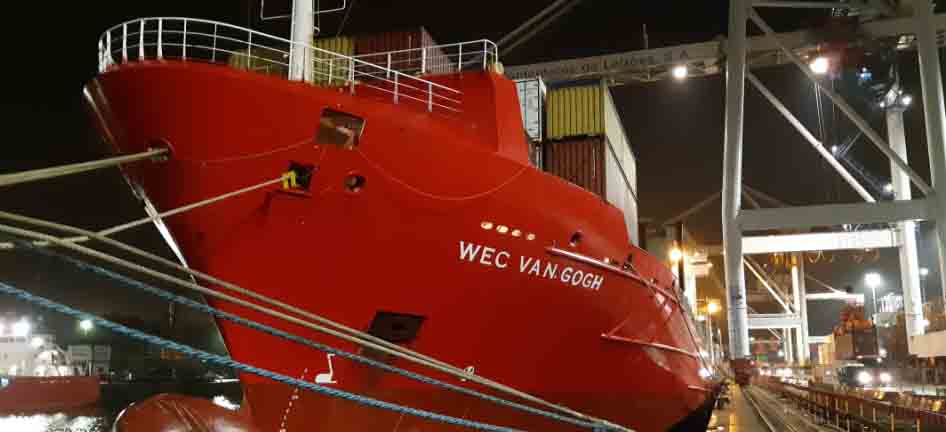

In September 2019, MSC Shipmanagement Ltd. became aware of a large crack in a propeller shaft onboard the WEC van Gogh, a small container feeder vessel in the company’s fleet, while it was dry-docked in Antwerp. A major issue immediately became apparent – producing a new shaft would take months, leading to lost contracts and a significant drop in earnings while the vessel was inactive. Fortunately, Wärtsilä was able to provide a unique, customised solution involving a short-term fix that allowed the ship to continue operations until the part could be fully replaced.
An urgent situation with unique challenges
By the time a crack was discovered in the vessel’s propeller shaft, it was already so severe that it was visible with the naked eye. At this point, MSC’s main concern was the time constraints they were facing – with a contract already in place, the vessel needed to be operational or the job would be lost. The situation was made more challenging by the fact that the shaft couldn’t simply be instantly replaced, as Thommy Svevar, General Manager, Global Field Service, Propulsion at Wärtsilä, explains. “Producing a new shaft isn’t a quick and easy job – it can take a significant amount of time to source the required materials and then carry out the machining and other processes needed to have the part ready.”
MSC initially approached the shaft’s original manufacturer to carry out the repairs and provide a temporary solution that would allow the vessel to return to service, but they were unable to provide an immediate solution. Since MSC had an existing service agreement with Wärtsilä, they contacted Wärtsilä’s field services team in Drunen, the Netherlands to discuss whether they could provide a temporary, fast-fix solution that would keep the vessel operational
Expertise that few can offer
Having conducted an inspection using non-destructive testing and root cause analysis to determine the severity and type of damage, Wärtsilä produced quotes for both a quick repair and the eventual replacement of the shaft. The repair proposal, which was sent to classification society Bureau Veritas for final approval, outlined a method using a pre-welding procedure that could be implemented in five or six weeks and would allow the ship to continue operating for another five months. As there were no technical drawings available, the Wärtsilä field services team had to use their initiative to produce a drawing for the proposal based on their own measurements of the shaft, which was approved with one minor change.
The repair was carried out while the ship was still dry-docked using laser-clad welding. “The technique uses a laser and powder with very little fusion and a low temperature – we couldn’t use normal welding as this would have put too much heat into the equipment,” says Carl Reijs, Technical Expert, Workshop Support, Propulsion. After the repair, the WEC van Gogh was permitted to operate for five months with a torque reduction and restrictions in place on the speed and level of usage. At the end of this period, with the coronavirus pandemic making it impossible to access the repair yard, Bureau Veritas granted an extension for a further five months’ operation based on Wärtsilä’s calculations and the condition of the repaired part. In August 2020, the ship was dry-docked again for the new shaft to be installed.

Maximising both short and long-term productivity
Thanks to the field services team’s unique expertise, Wärtsilä was able to offer a perfectly balanced solution that catered to MSC’s need to honour existing contracts by keeping the ship operational in the short term while also providing a full repair within the required timeframe. The whole job was carried out with impressive speed and flexibility, including inspection, sourcing the required materials and repair – displaying a level of skill and commitment the team are well known for. “Anything is possible when you have the right expertise – Wärtsilä has personnel with the creativity to find unique solutions to challenges like this,” explains Reijs.
While ordering a new shaft straight away would have led to around six months of inactivity for the vessel, Wärtsilä was able to minimise downtime with a complete solution that was also cost-effective. “We want to support our customers as flexibly as we can so that they’re never left stranded. In this case, rather than simply trying to sell MSC a new shaft, we got creative to offer them a more suitable solution to their specific challenge,” Reijs emphasises. “MSC placed their trust in the professionalism and capabilities of our team to come up with both a temporary and a permanent solution to their challenge. They actively participated in the review of technical drawings and calculations together with us and Bureau Veritas.”
“We are once again reassured to know we can rely on Wärtsilä to provide exceptional solutions with a smooth, convenient service. Not only did the short lead time on the temporary repair reduce our downtime and help us to avoid a loss of contract, we received stamped class approval even though the shaft wasn’t an original Wärtsilä part.”
- Vivek Goyal, Deputy General Manager – Fleet 1, MSC Shipmanagement Ltd.
Related solutions
Did you like this? Subscribe to Insights updates!
Once every six weeks, you will get the top picks – the latest and the greatest pieces – from this Insights channel by email.



